In addition to the information given below, it is mandatory to read and observe the safety information
and installation instructions shown in the installation manual. The technical documentation and the
interface and management software for the product are available on the website.
The equipment must be used in accordance to what is described in this Quick Installation Guide.
Otherwise, the protections guaranteed by the inverter may be affected.
Quick Installation Guide
UNO-DM-6.0-TL-PLUS
(6.0 kW)
ABB solar inverter
1.
Labels and Symbols
Models and Inverter Components
2.
Lifting and transportation
3.
EN
Assembly instructions
6.
Choice of the place of installation
4.
Supplied component list
5.
8.
Input connection (DC) and input congurations
7.
Opening the cover
The labels on the inverter show the markings, main technical data and the identication of the equipment and of the manufacturer.
The below labels are intended as example only: in fact other models are available.
A4 1:1 1/1
Regulatory Label of UNO-DM-6.0-TL-PLUS-SB-G
XLP.V2R03.0AL AA
A.Statuti
A.Butini
G.Fiesoli
C.Granci
07/09/2017
07/09/2017
07/09/2017
07/09/2017
Pantone
Process Cyan C Process Yellow C
LABEL MATERIAL: 3M type 7331 (UL R/C, PGJI2)
INKS: Refer to UL File MH16411
LABEL CONTENT: Fixed as shown in the picture
SIZE: 68 mm (height) x 75 mm (width)
MODEL:
UNO-DM-6.0-TL-PLUS-SB-G
V
dc max
V
acr
IP65
-25 to +60 °C
-13 to +140 °F
(1): @ 45°C amb. (2): Over/Under excited
600 V
90 - 580 V
2 x 20 A
160 - 480 V
2 x 24 A
230 V 1Ø
50 Hz
6000 W
(1)
6000 W
(1)
0.1 - 1
(2)
6650 VA
I
dc max
V
dc MPP
V
dc, Full Power
I
sc max
f
r
A
dj cosφ
P
acr (cos =
±
0.9)
φ
P
acr (cos = 1)φ
S
max
30 AI
ac max
5 minutes
INVERTERSOLAR
www.abb.com/solar
Made in Italy
DIN V VDE V 0126-1-1
PROTECTIVE CLASS: I
All
material
used
and finished product, must meet the requirements of the current RoHS
rec ti
i
ve 2002/95/EC.
Title
Issued
Modified
D
D
esign approved
Elec. Eng. approved
Mfg. approved
Size Scale Dim. in mm Sheet Drawing No. Revision
© Copyright 2017 Power-One Italy Spa. All rights reserved. Reproduction, use or disclosure to third parties without express written authority is strictly forbidden.
UNO-DM-X.X-TL-PLUS
P/N:PPPPPPPPPPP
WO:XXXXXXX
SO:SXXXXXXXX Q1
SN:YYWWSSSSSS WK:WWYY
Product Label (In case of a service password
request, it is necessary to have the serial number
available (SN: YYWWSSSSSS))
Wireless Identification Label (The label is divided in
two separate parts by a dashed line; take the bottom part
and apply it on the cover of this quick installation guide)
Regulatory Label
The labels placed on the equipment absolutely MUST NOT be removed, damaged, dirtied, hidden, etc.
In the manual, and/or in some cases on the equipment, the danger or attention zones are indicated by signs, labels, symbols or icons.
Obligation to consult the
manual
General warning - Important
safety
information
Dangerous voltage Hot parts
IP65
Degree of protection of the
device
Temperature interval
Without isolating
transformer
Direct and alternating
current respectively
Positive and negative pole
of the input voltage (DC)
Obligation to use protective
clothing and/or personal
protective equipment
Point of connection of the
protective ground
Discharge time of the
stored energy
The following variants are available (sufx could be combined):
- Models with “B” sufx (e.g. UNO-DM-6.0-TL-PLUS-B). Models equipped with Wireless communication.
- Models with “S” sufx (e.g. UNO-DM-6.0-TL-PLUS-S). Models equipped with DC disconnecting switch.
- Models with “E” sufx (e.g. UNO-DM-6.0-TL-PLUS-E). Models equipped with Wireless communication and Accessory Board equipped with Ethernet board
(UNO-DM-PLUS-COM Etherner KIT).
- Models with “X” sufx (e.g. UNO-DM-6.0-TL-PLUS-X). Models equipped with Accessory Board (UNO-DM-COM KIT).
- Models with “G” sufx (e.g. UNO-DM-6.0-TL-PLUS-G). Models equipped with AC connection with cable gland and terminal block.
Main components
01
Bracket
02
Lock spring
03
Heatsink
04
Anti-condensation valve
05
Front Cover
06
LED panel
07
Display
08
Keypad
09
DC Input Connectors
10
AC cable gland
11
Wireless antenna connector
12
DC Input terminal block
13
AC Output terminal block
16
DC disconnect switch
(only -S models)
18
UNO-DM-COM KIT card
(optional)
19
External ground connection
20
Service cable gland
Components supplied with the inverter Quantity
Bracket for wall xing 1
M25 Cable glands 1
Wireless antenna 1
Cable with faston isolated for the
conguration of the input channels
in parallel
1 + 1
(Spare part) T20 screw for front cover 1
Components supplied with the inverter Quantity
M5x10 screw for the external ground
connection
1
M5 contact washers for the external
ground connection
2
M5x10 Wall bracket locking screws
(optionally mounting, to be used if
required)
2
M5 Wall bracket locking washers
(Optionally mounting, to be used if
required)
2
In addition to what is explained in this guide, the safety and installation information provided in the installation manual must be read and followed.
The technical documentation and the interface and management software for the product are available at the website.
XXXXXXXXXXXXXXXXXXX
XXXXXXXXXXXXXXXXXXX
ABB solar inverters
Technical documentation 1
Transportation and relocation
The transportation of the device, in particular via land transportation, must be made with adequate
means and ways to protect the parts from violent impacts, humidity, vibrations, etc.
Lifting
The means used for lifting must be suitable to bear the weight of the equipment.
Weight of the equipment components
Model Weight
All models 20.5 kg / 45.2 lb
Unpacking and inspection
The packaging components must be removed and disposed of according to the applicable
regulations of the country where the device is installed.
Upon opening the packaging, check the integrity of the equipment and verify that all the
components are present.
If you notice defects or deterioration, stop the operations and call the carrier, as well as inform
ABB Service immediately.
Please keep the packaging in the event it has to be returned; the use of inadequate packaging will
void the warranty.
Always store the Quick Installation Guide, all the supplied accessories
and the AC connector cover in a safe place.
Do not open the inverter in case of rain, snow or
high humidity (>95%). During the installation, do
not place the inverter with the front cover
05
facing
the ground.
Install the inverter by following this procedure:
• Place the bracket
01
level on the wall and use it as a drilling
template.
• The selection of the appropriate number and distribution of the
anchors is the responsibility of the installer. The choice must
be made according to the type of wall, frame or other type of
support, and should be sized considering a total load of more
than 4 times the weight of the inverter (total 4x20.5=82 kg
total). Depending on the type of anchor chosen, drill the holes
required for the xing of the bracket (Figure
A
).
• Fix the bracket to the wall or structure.
• Carefully lift the inverter and hook it onto the bracket by
inserting the two supports in the slots on the inverter (Figure
B
).
• Proceed to anchor the inverter to the bracket by pressing the
lower part toward the wall or structure until the two springs on
the bracket set the inverter in position (Figure
B
).
• Install wireless antenna by screwing it into the dedicated
connector located on the bottom part of inverter
11
(Figure
C
).
WARNING! ELECTRIC SHOCK HAZARD! Hazardous voltages may be present inside the
inverter. The access to the internal zones of the inverter must be carried out after a
minimum waiting time of 5 minutes since the inverter was disconnected from the grid
and from the photovoltaic generator.
• The main connections are made on the lower part (outside) of the inverter. To install the accessories and make the
necessary connections, unscrew the 8 screws using a TORX T20 key and open the front cover
05
; while removing
the screws, pay special attention since additional screws are not supplied.
Caution! It is necessary to hold the front cover during the removal of screws to avoid the cover
falling (the front cover is not secured to the inverter’s chassis).
• After making the connections, close the cover by tightening the 8 screws on the front, while respecting the sequence
and tightening torque (2.5 Nm).
1
8
6
5
7
3
2
4
05
07
06
13
12
01
03
08
02
03
01
16
09
04
10 20
11
18
19
Place and position of installation
- Refer to the technical data for the verication of the environmental conditions to be
met.
- Do not install the inverter where it is exposed to direct sunlight. If necessary, use
protection that minimizes the exposure, especially for ambient temperatures above
40°C/104°F.
- Do not install in small unventilated spaces where the air cannot circulate freely.
- Always ensure that the airow around the inverter is not blocked to prevent
overheating.
- Do not install near ammable substances (minimum distance 3 m/10 ft).
- Do not install on wooden walls or other ammable substances.
- Do not install inside residential premises or where a prolonged presence of people
or animals is planned, due to the acoustic noise that the inverter produces during
operation. The noise emission value is strongly inuenced by the installation
location (e.g. type of surfaces around the inverter, general properties of the room,
etc.) and the quality of electricity supply.
- Install on a solid wall or structure that is suitable to support the weight of the
equipment.
- Install in an upright position with a maximum inclination as shown in the gure.
- Respect the minimum distances indicated. Choose a location that allows enough
space around the unit to allow easy installation and removal of the equipment from
the mounting surface.
- Where possible, install at eye level for easy viewing of the display and the LEDs.
- Install at a height that takes into account the weight of the equipment.
- When installing multiple inverters, position the inverters side by side while
maintaining the minimum distances (measured from the outer edge of the inverter);
if the space available does not allow this provision, position the inverters in a
staggered layout, as indicated in the gure, in order to make sure that the heat
dissipation is not affected by the other inverters.
- All installations at altitudes above 2,000 m/6,500’ must be assessed on a case by case basis with ABB Service to determine the proper derating of the input
parameters.
The nal installation of the inverter must not compromise the access to any disconnection devices located outside.
Refer to the warranty conditions to evaluate the possible exclusions related to an improper installation.
15
cm
10 cm 10 cm
20
cm
5° MAX5° MAX
NONO
Check the correct polarity of the input strings and the absence of earth leakages of the PV generator. When the PV panels are exposed
to sunlight, they provide a continuous voltage (DC) to the inverter. Access to the internal inverter zones must be carried out with the
equipment disconnected from the grid and from the PV generator.
Caution! The inverters referred to in this document are WITHOUT AN ISOLATION TRANSFORMER (transformer-less). This type involves the
use of PV panels of an isolated type (IEC61730 Class A Rating) and the need to maintain the PV generator oating with respect to earth; no
generator pole must be connected to the ground.
If multiple strings are connected to the same input, they must have the same type and number
of panels in series. ABB also recommend they have the same orientation and inclination.
• Observe the maximum input current with respect to quick-coupling connectors. Refer to “String inverters -
Product manual appendix” document available on the site www.abb.com/solarinverters, to nd out the make and
model of the quick-coupling connector used on the inverter. Depending on the model of the connectors installed
on your inverter, it will be necessary to use the same model for the corresponding counterparts (by checking the
manufacturer’s website or via ABB for the compliant counterpart).
The use of non-compliant counterparts with respect to the quick-coupling connectors models
present on the inverter, may cause serious damage to the unit and result in the immediate
loss of warranty
• Connect the DC input, always checking the tightness of the connectors.
• Versions of the inverter which are equipped with two independent input channels (i.e. dual maximum power point tracker, MPPT), can be congured as parallel
(i.e. single MPPT).
Conguring Input Mode to Independent (default conguration)
This conguration is set at the factory and involves the use of the two input channels (MPPT) in
an independent mode. This means that the jumpers (supplied) between the positive and negative
poles of the two DC input channels
12
must not be installed, and that the independent channel
mode should be set during the commissioning phase, in the dedicated section of the internal
webserver “SETTINGS > SETUP DC SIDE > INPUT MODE” or through the inverter display menu
“SETTINGS> INPUT MODE”.
DC INPUTS
-IN1 -IN1 +IN1 +IN1 +IN2 +IN2-IN2 -IN2
Conguring Input Mode to Parallel
This conguration involves the use of the two input channels (MPPT) connected in parallel. This
means that the jumpers (supplied) between the positive and negative poles of the two DC input
channels
12
must be installed, and that the parallel channel mode should be set during the
commissioning phase, in the dedicated section of the internal webserver “SETTINGS > SETUP
DC SIDE > INPUT MODE” or through the inverter display menu “SETTINGS> INPUT MODE”.
APPLY HERE
THE WIRELESS
IDENTIFICATION LABEL
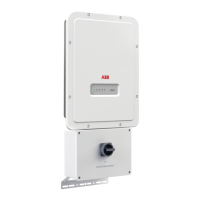
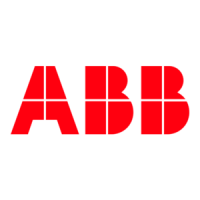

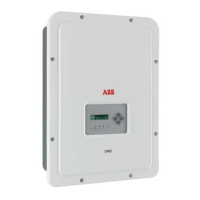
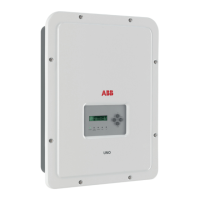
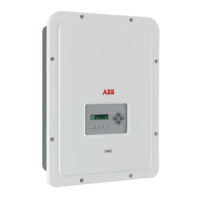
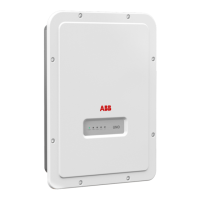

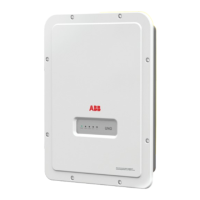

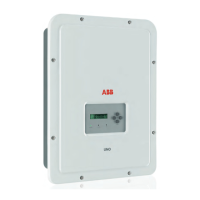

